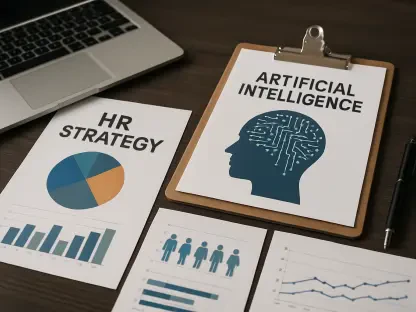In recent years, technology has emerged as a pivotal force in reshaping workplace gender equality by introducing tools and innovations that challenge entrenched disparities and support inclusive practices. By leveraging artificial intelligence (AI) and digital solutions, organizations can facilitate fairer work environments and address the specific healthcare needs of women. As conversations on gender parity continue to evolve, it becomes increasingly evident that tech-driven strategies play a significant role in advancing meaningful progress and creating equitable workplaces.
The Role of AI in Healthcare
Menstrual and Menopause Support
AI is instrumental in addressing women’s unique health needs, particularly with regard to menstrual and menopause support. Leveraging data-driven insights, AI offers personalized healthcare experiences that alleviate workplace challenges related to these conditions. AI technology helps in understanding, predicting, and managing menstrual cycles and menopause transitions, thereby improving workplace productivity and enhancing comfort for female employees. AI solutions empower women with greater knowledge of their health, allowing them to make informed decisions that balance their health needs with professional obligations.
As AI-powered tools become more pervasive, they offer women greater autonomy in managing their health. Such technologies facilitate real-time monitoring and predictive analysis of menstrual and menopause symptoms, providing personalized guidance and interventions. Women can access discreet support systems that offer advice and recommend solutions tailored to individual health needs, minimizing disruptions caused by health-related issues. By integrating these technologies into workplace health strategies, organizations can create supportive environments where women’s specific health concerns are acknowledged and addressed effectively.
Enhancing Healthcare Access
The integration of AI into healthcare systems is profoundly enhancing access to services and information, breaking down traditional barriers faced by women in workplace contexts. AI democratizes health data, empowering individuals to take charge of their well-being and make informed choices regarding health management. The accessibility of AI-driven insights facilitates remote consultations and enhances the understanding of health trends, allowing employees to access healthcare services without inconvenient disruptions.
With AI’s ability to conduct predictive health analyses, women can proactively address health concerns, receiving timely interventions that align with their personal and professional responsibilities. These technologies are pivotal in reducing stigma and anxieties associated with seeking support, providing women with a platform to balance health needs while contributing effectively to workplace goals. Remote accessibility ensures that support is available irrespective of geographical constraints, fostering an inclusive atmosphere where women feel encouraged to leverage healthcare technologies for improved quality of life and work engagement.
Economic Empowerment Through Tech
Bridging the Gender Gap
Technology serves as a catalyst for fostering economic empowerment by bridging the gender gap, offering digital platforms that grant access to financial resources, entrepreneurial opportunities, and flexible work arrangements. These advancements contribute to leveling economic disparities between genders, facilitating pathways toward financial independence and parity. Women benefit from online networks that facilitate the exchange of knowledge and resources, enhancing their ability to pursue professional opportunities and establish supportive economic environments.
Online communities provide invaluable platforms where women can collaborate, sharing insights and resources that propel economic growth. Digital tools enable flexible work arrangements that accommodate diverse needs and schedules, empowering women to balance personal responsibilities with professional aspirations. By embracing technology, women can navigate economic landscapes with greater ease and security, capitalizing on platforms that prioritize accessibility and inclusivity. Ultimately, technology serves as a beacon for reshaping financial dynamics, offering women amplified voices and sustained economic empowerment.
Policy and Innovation
Technological advancements are increasingly prompting policy shifts that support gender equality. As technology continues to evolve, policymakers recognize the necessity of integrating digital solutions into regulatory frameworks, ensuring that women benefit equally from technological progress. Innovations such as blockchain streamline processes and reduce intermediaries in financial transactions, offering women greater autonomy and security in managing economic activities.
Policy reforms driven by technological advancements advocate for inclusive regulatory measures that address gender-specific challenges. These reforms facilitate the creation of equitable economic opportunities, ensuring women have access to platforms that support financial growth. By adopting technologies that streamline administrative processes, women can navigate financial landscapes with enhanced autonomy, experiencing reduced barriers to economic participation. Such innovations foster environments where women can thrive, benefiting from policies that prioritize fairness and equality within digital transformation.
Coalition Building for Systemic Change
Partnerships Across Sectors
Achieving workplace gender equality through technology necessitates collaboration across sectors, engaging stakeholders from governments, businesses, and tech innovators to create comprehensive strategies that tackle systemic inequalities. Cross-sector partnerships are instrumental in facilitating the sharing of best practices and resources, enabling cohesive efforts toward achieving gender parity.
These collaborative initiatives bring diverse perspectives together, creating platforms for sharing insights and formulating solutions that address institutional gender disparities. By drawing on expertise from varied sectors, coalitions can develop multifaceted strategies that integrate technological solutions with policy reforms, prioritizing inclusivity and accessibility. Engaging stakeholders through partnerships ensures that strategies for gender equality are sustainable, creating environments where women and men can collaborate in achieving shared goals.
Advocacy and Awareness
Technology is a powerful tool for advocacy and awareness regarding gender equality issues, offering digital campaigns and platforms that amplify marginalized voices and draw attention to persistent inequalities. Advocacy initiatives facilitated by technology mobilize action by highlighting disparities and fostering dialogue among stakeholders.
Digital platforms serve as conduits for raising awareness about gender-related challenges, promoting narratives that challenge biases and reinforce the necessity of systemic change. Online education and training programs empower women with skills needed to thrive in the digital economy, dismantling barriers to professional advancement. These educational initiatives equip individuals with the competencies required to navigate technological landscapes, encouraging participation in economic activities that contribute to professional growth and equality.
The Importance of Inclusive Tech Design
Gender-Sensitive Development
Inclusivity in tech design is paramount to ensuring products and solutions cater to diverse user groups. Incorporating gender sensitivity in development phases helps avoid biases, facilitating the creation of effective outcomes for all genders. Engaging women in tech design processes fosters environments where inclusivity and accessibility are prioritized, encouraging equitable opportunities for users across various demographics.
Gender-sensitive design considerations lead to the development of products that address specific needs and challenges faced by diverse groups. Stakeholders who prioritize inclusivity in tech design advocate for solutions that reflect diverse experiences, bridging gender disparities in technological access and implementation. Involving women in tech innovation processes enhances product relevance, allowing for the creation of solutions that are both practical and beneficial for all users.
Addressing Biases in Technology
Acknowledging and addressing biases in technology is crucial for achieving genuine gender equality. Technological tools must be scrutinized for inherent biases and pitfalls that could perpetuate existing disparities, ensuring they serve as equalizers in fostering gender equity. Efforts to diversify tech teams and promote inclusive cultures are essential in eliminating biases and ensuring that technology acts as a bridge rather than a barrier.
Diversification within tech teams can challenge prevalent biases, fostering environments where diverse perspectives are valued and explored. These efforts cultivate inclusive cultures within organizations, encouraging proactive approaches to identifying and mitigating biases within technology design and implementation. By advocating for diversity, stakeholders empower tech innovators to develop solutions that transcend gender-based restrictions, promoting equitable access and usage across platforms.
The Evolving Narrative of Gender Equity
Shifting Perspectives
The narrative surrounding gender equity is evolving, with increasing recognition that technological advances must align with strategic policy changes to foster genuine progress. Societal perspectives are shifting as advocacy and awareness campaigns highlight gender equality as both a moral imperative and an economic benefit.
As technology continues to redefine workplace dynamics, stakeholders are increasingly aware of the role it plays in facilitating inclusivity. Insights garnered from advocacy initiatives encourage the alignment of tech-driven strategies with policy reforms, fostering environments where gender disparities are minimized. Collective understanding of gender equity emphasizes the intersection of technology and policy, highlighting the necessity of aligning advancements with equitable principles.
Collective Actions for a Common Goal
Collective action and inclusivity are fundamental in driving the gender equity agenda forward, urging stakeholders at all levels to work collaboratively toward a shared objective that reflects diverse experiences. As technology evolves, commitment to gender equality must persist, ensuring innovations are leveraged to create fair and inclusive environments.
Stakeholders are called to unite in embracing collective actions that champion gender equity, advocating for comprehensive strategies that prioritize inclusivity and collaboration. By drawing on diverse insights and experiences, initiatives can highlight barriers and advocate for strategies that address challenges faced by varied groups. As technological innovation advances, it remains crucial to maintain momentum in advocating for gender equity, ensuring these efforts establish egalitarian environments across workplaces globally.
Future Pathways and Innovations
In recent times, technology has increasingly become a crucial element in the movement toward workplace gender equality. This is a shift marked by the advent of transformative tools and innovations specifically designed to challenge long-standing disparities, thereby fostering more inclusive labor practices. The use of artificial intelligence (AI) and digital solutions is at the forefront, enabling organizations to create fairer work environments that cater to the distinct healthcare necessities of women. As discussions around gender equality evolve, it’s becoming ever clearer that tech-driven approaches are essential in driving genuine advancement toward more equitable workplaces. These technologies not only revolutionize daily operations but also assist in tailoring benefits and policies that address gender-specific requirements, effectively bridging gaps that have persisted for decades. Furthermore, by embracing AI, companies can analyze performance data objectively, identify bias in hiring practices, and improve diversity in teams. In combination with digital platforms, AI can improve work-life balance, offering flexible solutions that support all genders in achieving professional success. Hence, technology acts not just as a tool but as a catalyst in the continuous pursuit of gender parity, shaping the modern work environment into one where equality isn’t merely an aspiration but a tangible reality.









